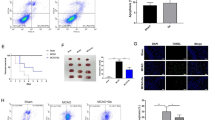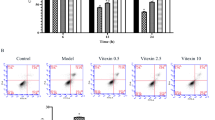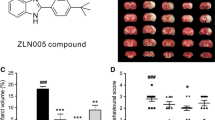Abstract
Neuroinflammation and oxidative stress damage are involved in the pathogenesis of cerebral ischemia–reperfusion injury (CIRI). Ferroptosis emerged as a new player in the regulation of lipid peroxidation processes. This study aimed at exploring the potential involvement of ciprofol on ferroptosis-associated CIRI and subsequent neurological deficits in the mouse model of transient cerebral ischemia and reperfusion. Cerebral ischemia was built in male C57BL/6 J wild-type (WT) and Nrf2-knockout (Nrf2 KO) mice in the manner of middle cerebral artery occlusion (MCAO) followed by reperfusion. Ciprofol improved autonomic behavior, alleviated reactive oxygen species output and ferroptosis-induced neuronal death by nucleus transportation of NFE2 like BZIP transcription factor 2 (Nrf2) and the promotion of heme oxygenase 1 (Ho-1), solute carrier family 7 member 11 (SLC7A11/xCT), and glutathione peroxidase 4 (GPX4). Additionally, ciprofol improved neurological scores and reduced infarct volume, brain water content, and necrotic neurons. Cerebral blood flow in MCAO-treated mice was also improved. Furthermore, absence of Nrf2 abrogated the neuroprotective actions of ciprofol on antioxidant capacity and sensitized neurons to oxidative stress damage. In vitro, the primary-cultured cortical neurons from mice were pre-treated with oxygen–glucose deprivation/reperfusion (OGD/R), followed by ciprofol administration. Ciprofol effectively reversed OGD/R-induced ferroptosis and accelerated transcription of GPX4 and xCT. In conclusion, we investigated the ciprofol-induced inhibition effect of ferroptosis-sheltered neurons from lipid preoxidation in the pathogenesis of CIRI via Nrf2-xCT-GPX4 signaling pathway.









Similar content being viewed by others
Data availability
The data used to support the findings of this study are available from the corresponding authors upon request.
References
Alim I et al (2019) Selenium drives a transcriptional adaptive program to block ferroptosis and treat stroke. Cell 177(5):1262-1279 e25
Alvarez SW et al (2017) NFS1 undergoes positive selection in lung tumours and protects cells from ferroptosis. Nature 551(7682):639–643
Ast T et al (2019) Hypoxia rescues frataxin loss by restoring iron sulfur cluster biogenesis. Cell 177(6):1507-1521 e16
Benjamin EJ et al (2017) Heart disease and stroke statistics-2017 update: a report from the American Heart Association. Circulation 135(10):e146–e603
Bersuker K et al (2019) The CoQ oxidoreductase FSP1 acts parallel to GPX4 to inhibit ferroptosis. Nature 575(7784):688–692
Cao C et al (2022) Starvation, ferroptosis, and prodrug therapy synergistically enabled by a cytochrome c oxidase like nanozyme. Adv Mater 34(29):e2203236
Chen CY et al (2018) Propofol inhibits endogenous formyl peptide-induced neutrophil activation and alleviates lung injury. Free Radic Biol Med 129:372–382
Dominguini D et al (2021) The effects of anaesthetics and sedatives on brain inflammation. Neurosci Biobehav Rev 127:504–513
Eisenstein A et al (2022) Activation of the transcription factor NRF2 mediates the anti-inflammatory properties of a subset of over-the-counter and prescription NSAIDs. Immunity 55(6):1082-1095 e5
Fan Z et al (2017) Nrf2-Keap1 pathway promotes cell proliferation and diminishes ferroptosis. Oncogenesis 6(8):e371
Fang X et al (2022) The molecular and metabolic landscape of iron and ferroptosis in cardiovascular disease. Nat Rev Cardiol 20(1):7–23
Freeman J et al (2019) Effect of perioperative lidocaine, propofol and steroids on pulmonary metastasis in a murine model of breast cancer surgery. Cancers (Basel) 11(5):613
Friedmann Angeli JP et al (2014) Inactivation of the ferroptosis regulator Gpx4 triggers acute renal failure in mice. Nat Cell Biol 16(12):1180–1191
Hambright WS et al (2017) Ablation of ferroptosis regulator glutathione peroxidase 4 in forebrain neurons promotes cognitive impairment and neurodegeneration. Redox Biol 12:8–17
Han J et al (2022) Propofol via antioxidant property attenuated hypoxia-mediated mitochondrial dynamic imbalance and malfunction in primary rat hippocampal neurons. Oxid Med Cell Longev 2022:6298786
Ingold I et al (2018) Selenium utilization by GPX4 is required to prevent hydroperoxide-induced ferroptosis. Cell 172(3):409-422 e21
Kang YP et al (2021) Non-canonical glutamate-cysteine ligase activity protects against ferroptosis. Cell Metab 33(1):174-189 e7
Kim JJ et al (2020) Shared structural mechanisms of general anaesthetics and benzodiazepines. Nature 585(7824):303–308
Kudo Y et al (2020) PKClambda/iota loss induces autophagy, oxidative phosphorylation, and NRF2 to promote liver cancer progression. Cancer Cell 38(2):247-262 e11
Li Y et al (2019) Ischemia-induced ACSL4 activation contributes to ferroptosis-mediated tissue injury in intestinal ischemia/reperfusion. Cell Death Differ 26(11):2284–2299
Li P et al (2021) Glutathione peroxidase 4-regulated neutrophil ferroptosis induces systemic autoimmunity. Nat Immunol 22(9):1107–1117
Liao B et al (2020) Adipocyte fatty acid-binding protein exacerbates cerebral ischaemia injury by disrupting the blood-brain barrier. Eur Heart J 41(33):3169–3180
Lin Q et al (2022) Hypertension in stroke survivors and associations with national premature stroke mortality: data for 2.5 million participants from multinational screening campaigns. Lancet Glob Health 10(8):e1141–e1149
Liu Y et al (2022) Safety and of ciprofol vs. propofol for sedation in intensive care unit patients with mechanical ventilation: a multi-center, open label, randomized, phase 2 trial. Chin Med J (Engl) 135(9):1043–1051
Loss of LPR8 Reduces GPX4 levels, resulting in ferroptosis sensitivity (2022) Cancer Discov 12(8):1835
Lu Y et al (2020) Propofol-induced MiR-20b expression initiates endogenous cellular signal changes mitigating hypoxia/re-oxygenation-induced endothelial autophagy in vitro. Cell Death Dis 11(8):681
Lu Z et al (2022) Propofol upregulates microRNA-30b to inhibit excessive autophagy and apoptosis and attenuates ischemia/reperfusion injury in vitro and in patients. Oxid Med Cell Longev 2022:2109891
Ma R et al (2018) A Pck1-directed glycogen metabolic program regulates formation and maintenance of memory CD8(+) T cells. Nat Cell Biol 20(1):21–27
Rodriguez AE et al (2019) Serine metabolism supports macrophage IL-1beta production. Cell Metab 29(4):1003-1011 e4
Sessler DI et al (2019) Recurrence of breast cancer after regional or general anaesthesia: a randomised controlled trial. Lancet 394(10211):1807–1815
Stockwell BR (2022) Ferroptosis turns 10: emerging mechanisms, physiological functions, and therapeutic applications. Cell 185(14):2401–2421
Stockwell BR et al (2017) Ferroptosis: a regulated cell death nexus linking metabolism, redox biology, and disease. Cell 171(2):273–285
Teng Y et al (2021) Pharmacokinetic and pharmacodynamic properties of ciprofol emulsion in Chinese subjects: a single center, open-label, single-arm dose-escalation phase 1 study. Am J Transl Res 13(12):13791–13802
Tian R et al (2021) Genome-wide CRISPRi/a screens in human neurons link lysosomal failure to ferroptosis. Nat Neurosci 24(7):1020–1034
Tuo QZ et al (2022) Thrombin induces ACSL4-dependent ferroptosis during cerebral ischemia/reperfusion. Signal Transduct Target Ther 7(1):59
Ubellacker JM et al (2020) Lymph protects metastasizing melanoma cells from ferroptosis. Nature 585(7823):113–118
Wang Y et al (2022) PRMT4 promotes ferroptosis to aggravate doxorubicin-induced cardiomyopathy via inhibition of the Nrf2/GPX4 pathway. Cell Death Differ 29(10):1982–1995
Wang YC et al (2023) Protective effects of combined treatment with ciprofol and mild therapeutic hypothermia during cerebral ischemia-reperfusion injury. World J Clin Cases 11(3):487–492
Wenzel SE et al (2017) PEBP1 wardens ferroptosis by enabling lipoxygenase generation of lipid death signals. Cell 171(3):628-641 e26
Wong Fok Lung T et al (2022) Klebsiella pneumoniae induces host metabolic stress that promotes tolerance to pulmonary infection. Cell Metab 34(5):761-774 e9
Yan R et al (2022) The structure of erastin-bound xCT-4F2hc complex reveals molecular mechanisms underlying erastin-induced ferroptosis. Cell Res 32(7):687–690
Yang WS et al (2014) Regulation of ferroptotic cancer cell death by GPX4. Cell 156(1–2):317–331
Zhong H et al (2018) Propofol inhibits parthanatos via ROS-ER-calcium-mitochondria signal pathway in vivo and vitro. Cell Death Dis 9(10):932
Acknowledgements
The authors would like to acknowledge the reviewers for their helpful comments on this paper.
Funding
This work was supported by the Ningbo Health Technology Project (grant No.2023Y12), and the National Natural Science Foundation of China, China (Grant No. 81704180).
Author information
Authors and Affiliations
Contributions
J.W. and C.H. are the corresponding authors and they performed study design; X.L., M.R. and A.Z. performed the experiments; X.L. analyzed the data; D.C. provided technical support; C.H revised the manuscript carefully; All authors read and approved the final paper.
Corresponding authors
Ethics declarations
Ethics approval and consent to participate
This study was approved and consented to by the ethics committee of the First Affiliated Hospital of Ningbo University.
Consent for publication
All the authors consented to publicize the article in the journal.
Competing interests
The authors declare no conflicts of interest.
Additional information
Publisher's Note
Springer Nature remains neutral with regard to jurisdictional claims in published maps and institutional affiliations.
Rights and permissions
Springer Nature or its licensor (e.g. a society or other partner) holds exclusive rights to this article under a publishing agreement with the author(s) or other rightsholder(s); author self-archiving of the accepted manuscript version of this article is solely governed by the terms of such publishing agreement and applicable law.
About this article
Cite this article
Liu, X., Ren, M., Zhang, A. et al. Nrf2 attenuates oxidative stress to mediate the protective effect of ciprofol against cerebral ischemia–reperfusion injury. Funct Integr Genomics 23, 345 (2023). https://doi.org/10.1007/s10142-023-01273-z
Received:
Revised:
Accepted:
Published:
DOI: https://doi.org/10.1007/s10142-023-01273-z




